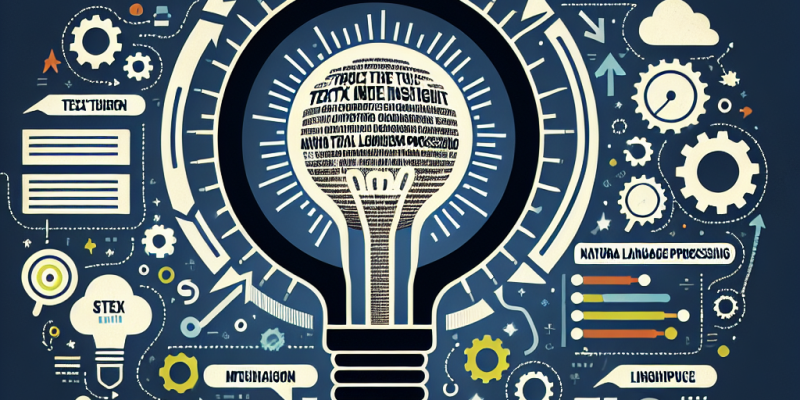From Text to Insight: The Rise of Natural Language Processing in Data Analytics

In recent years, the digital landscape has been transformed by a deluge of unstructured data, primarily in the form of text. With the rise of social media, customer feedback, news articles, and online forums, organizations are faced with a wealth of information that, until recently, remained largely untapped. However, the advent of Natural Language Processing (NLP) has revolutionized how businesses analyze textual data, enabling them to convert raw text into actionable insights.
Understanding Natural Language Processing
Natural Language Processing is a subfield of artificial intelligence that focuses on the interaction between computers and human (natural) languages. It encompasses a variety of techniques designed to enable machines to understand, interpret, and generate human language in a valuable manner. NLP technologies are designed to perform tasks such as sentiment analysis, topic modeling, language translation, summarization, and named entity recognition. By leveraging these techniques, organizations can glean insights from vast amounts of text data that were previously difficult to analyze.
The Data Explosion and the Need for NLP
According to various estimates, over 80% of the world’s data is unstructured. This figure emphasizes the challenge faced by analysts and organizations trying to derive insights from such data, particularly when it comes to textual information. Traditional data analytics methods, primarily focused on structured data (numbers and categorical information), fall short when handling the complexity and subtleties of human language.
NLP fills this gap by providing the tools needed to analyze large volumes of text data efficiently. Its rise parallels developments in machine learning and deep learning, where advances in algorithms and computing power have significantly improved the capabilities of NLP applications. Techniques such as word embeddings (e.g., Word2Vec, GloVe) allow for the contextual understanding of language, giving machines the ability to distill meanings, patterns, and sentiments from text.
Applications of NLP in Data Analytics
-
Sentiment Analysis: Businesses increasingly utilize sentiment analysis to gauge customer opinions and emotions expressed in reviews, social media posts, and other feedback. By analyzing sentiment, companies can identify trends, respond to customer concerns, and improve their products or services.
-
Customer Experience Optimization: NLP can analyze customer interactions across various channels (emails, live chats, and phone calls) to unearth insights on pain points and service bottlenecks. This information can help businesses tailor their customer experiences, enhancing engagement and satisfaction.
-
Market Research: NLP tools can sift through news articles, blogs, and forums to identify emerging trends, competitor analyses, and consumer preferences. This capability enables businesses to remain competitive and proactive in their marketing strategies.
-
Automated Reporting and Summarization: With the growing volume of data, decision-makers require concise and easily digestible reports. NLP can automate summarization processes, allowing the extraction of key insights from long articles or reports, thus saving valuable time for analysts.
- Fraud Detection and Compliance: In finance and insurance, NLP can help detect fraudulent activities by analyzing communication patterns and flagged language in customer interactions. Moreover, it can ensure compliance with regulations by monitoring and interpreting language in contracts and legal documents.
Challenges and Ethical Considerations
While the rise of NLP in data analytics brings remarkable benefits, it also introduces challenges. NLP systems can inherit biases present in the training data, leading to skewed insights or discriminatory outcomes. Ensuring the integrity and fairness of machine learning algorithms is paramount, requiring continuous evaluation and refinement of the models in use.
Additionally, privacy concerns related to personal data also come to the forefront when analyzing text from communications. Organizations must navigate these ethical dilemmas, balancing the need for insights with the rights of individuals.
The Future of NLP in Data Analytics
Looking ahead, the role of NLP will continue to expand as organizations recognize the importance of unstructured data in their decision-making processes. Advances in language models, such as OpenAI’s GPT-3 and similar technologies, showcase the potential for creating more sophisticated applications that can understand context and nuance in human language.
As NLP becomes increasingly integrated into enterprise analytics platforms, organizations will be better equipped to harness the power of textual data, turning vast stores of information into a clear and actionable roadmap for success. The ongoing evolution of this technology promises a future where data-driven insights are more accessible, impactful, and transformative for businesses across industries.
In conclusion, the rise of Natural Language Processing marks a significant milestone in the world of data analytics. By bridging the gap between human language and machine understanding, NLP empowers organizations to unlock the potential hidden within unstructured data, turning text into invaluable insights that drive strategic decision-making and innovation. As technology progresses, the partnership between NLP and data analytics will undoubtedly continue to flourish, shaping the future of how we understand and interact with information.














